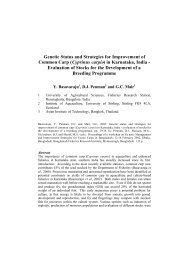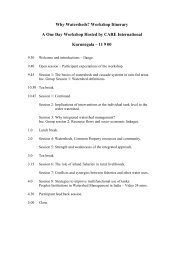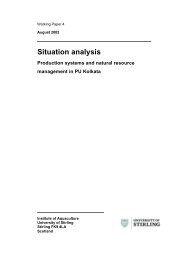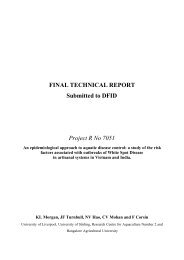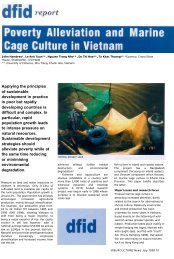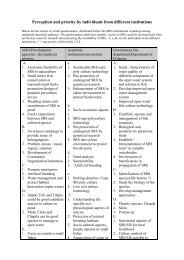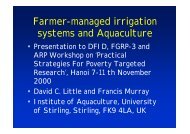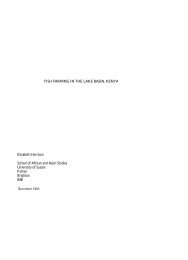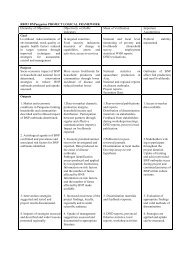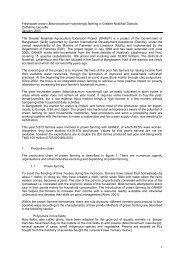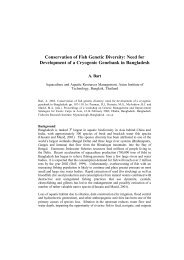<strong>Epizootic</strong> <strong>Ulcerative</strong> <strong>Syndrome</strong> (<strong>EUS</strong>) <strong>Technical</strong> <strong>Handbook</strong>1994b). Therefore, some other factor was considered to be involved in thedisease process. Virgona (1992) showed that RSD outbreaks in estuarine fishin the Clarence river, NSW were associated with lower catchment rainfall andCallinan et al. (1995a) related this to runoff from acid sulfate soils. Ultrastructuralexamination of fish gills and skin showed that the low pH and elevatedconcentrations of monomeric aluminium, representative of estuarineacidification, induces significant lesions in fish (Sammut et al., 1996). Inaquarium trials, RSD was subsequently induced in fish exposed sublethallyto artificially acidified water (at both pH 3 and pH 5) and pathogenicAphanomyces spores, even at low concentrations of monomeric aluminium(Callinan et al., 1996; Callinan, 1997). As with A. piscicida, the pathogenicRSD-Aphanomyces has been shown to be the same species as the <strong>EUS</strong>pathogen, A. invadans (Callinan et al., 1995a; Lilley et al., 1997a; b).<strong>Epizootic</strong> ulcerative syndrome (<strong>EUS</strong>)Following the outbreaks of MG and RSD, there was a progressive spreadwestwards across Asia of a syndrome associated with dermal ulceration andinvolving large scale mortalities in a number of freshwater and estuarine fishspecies. The syndrome was given its present name, epizootic ulcerativesyndrome (<strong>EUS</strong>), in 1986 at the Consultation of Experts on <strong>Ulcerative</strong> FishDiseases in Bangkok (FAO, 1986). Outbreaks of <strong>EUS</strong> have been reported in 18countries of the Asia-Pacific region (Figure 1), although not all have beenpositively confirmed as <strong>EUS</strong> according to procedures described in the Diagnosissection of this handbook.In 1975-6, an ulcerative disease outbreak, believed to be <strong>EUS</strong>, occurred in therivers of southern Papua New Guinea (Haines, 1983). In 1982-3, there werehigh mortalities in gudgeon (Ophieleotris aporos and Oxyeleotris heterodon)from inland areas and mullet from estuaries in northern Papua New Guinea(Coates et al., 1989). Introduced tilapia (Oreochromis mossambicus) arecommon in these areas, but they proved resistant. Preserved affected fish werelater examined by Roberts et al. (1986) and confirmed as pathologicallyidentical to <strong>EUS</strong>.In 1980 outbreaks of an epizootic haemorrhagic condition occurred in Java,Indonesia affecting primarily cultured cyprinid and clariid fish, althoughwhether this was <strong>EUS</strong> is uncertain (Roberts et al., 1986). Typically ulceratedsnakeheads and catfish have subsequently been reported in the Indonesianstates of Sumatra, Sulawesi and Kalimantan (Widagdo, 1990). Invasivehyphae have been identified from sand gobies (Oxyeleotris marmoratus) fromeastern Kalimantan (Rukyani, 1994), and D. Bastiawan (pers. comm.) isolatedA. invadans from an <strong>EUS</strong>-affected sand goby from Java in 1993.Roberts et al. (1986) discussed unconfirmed accounts of ulcerated walkingcatfish (Clarias batrachus) in Singapore in 1977 and of subsequent occurrencesthereafter. Despite Singapore’s status as a centre of trade in <strong>EUS</strong>-susceptibleornamental fishes there have been no records of high <strong>EUS</strong> losses to thisindustry.4
HistoryAlthough there were reports of high mortality rates in fish in southernpeninsular Malaysia in 1979 (Shariff and Law, 1980, described by Roberts etal., 1986), the first reported typical <strong>EUS</strong> outbreaks were in December 1980, inrice-field fishes in northern Malaysia (Jothy, 1981). These have recurredannually ever since, albeit to a lesser extent (Shariff and Saidin, 1994). Majorspecies affected are snakeskin gourami (Trichogaster pectoralis), stripedsnakehead (Channa striata), climbing perch (Anabas testudineus) and walkingcatfish (Shariff and Saidin, 1994).Significant, well-documented epizootics have occurred annually in Thailandsince 1981 (<strong>Ulcerative</strong> Fish Disease Committee, 1983; Chulalongkorn University,1983; 1985; 1987). The second (1982-3) and third (1983-4) outbreaks wereparticularly devastating as they affected the intensive fish culture systems ofcentral Thailand as well as wild fish in natural waterways. Some of the mostsevere mortalities were in farmed snakeheads and rice-field fish. The originaloutbreaks started towards the end of the rainy season (September) andpersisted throughout the cool season to March. Outbreaks now tend to berestricted to the coolest months of December and January. Recently (December1996), <strong>EUS</strong> was experienced in NE, central and southern provinces (S.Kanchanakhan, unpublished). The isolation of the pathogenic fungus, A.invadans, from <strong>EUS</strong>-affected snakeheads in Suphanburi province was describedby Roberts et al. (1993).Myanmar, Lao PDR and Cambodia, first reported major outbreaks of <strong>EUS</strong> in1983 or 1984 (Lilley et al., 1992). Subsequent epizootics were less extensive(e.g. <strong>EUS</strong> affected 35 Burmese townships in 1984-85 and 11 townships in1989-90: Soe, 1990), but given the importance of susceptible fish to ruralcommunities in these countries, the impact continues to be significant. In1996, diseased snakeheads from Laos were confirmed at AAHRI, Bangkok assuffering from <strong>EUS</strong>.Several accounts of <strong>EUS</strong>-affected fish have also come from Vietnam, China andHong Kong although these are still not confirmed. The first report of ulceratedsnakeheads in Vietnam, and therefore the most likely first occurrence of <strong>EUS</strong>in that country, came from the Mekong delta in 1983 (Xuan, 1990). UlceratedLabeo rohita were first observed at the Pearl River Fisheries Institute inGuangzhou, South China in 1982 (Lian, 1990). Clariid catfish were affected inthe same area in 1987-8 (Lian, 1990) and Carassius auratus were reportedlyaffected over much of Eastern China in 1989 (Guizhen, 1990). Wilson and Lo(1992) reported seasonal mortalities of up to 70% of snakeheads (Channamaculata) in late summer in Hong Kong since 1988.Laguna de Bay in the Philippines, experienced a serious outbreak of <strong>EUS</strong> inDecember 1985. An estimated 5-40% of snakeheads, gobies, gouramies,catfish, crucian carp, Arius sp. and Therapon sp. were ulcerated, whereasmilkfish, bighead carp, and tilapia were unaffected (Llobrera and Gacutan,1987). The disease continued to spread to at least 11 other provinces affectingwild fish in lakes, rice-fields and swamps and pond cultured fish (Bondad-Reantaso et al., 1994). Mullet, goatfish (Upeneus bensai), croaker (Johnius sp.),Psettodes sp. and Scanthophagus argus in a lagoon in Cagayan Province5
- Page 3 and 4: Epizootic Ulcerative Syndrome(EUS)T
- Page 5 and 6: Copies of this publication are avai
- Page 7 and 8: This handbook is one of a series of
- Page 9 and 10: ContentsIntroduction ..............
- Page 11 and 12: IntroductionEpizootic ulcerative sy
- Page 13: HistoryFor over 25 years, outbreaks
- Page 17 and 18: HistoryShresta, 1994). It is estima
- Page 19 and 20: Species affectedMore than 100 fish
- Page 21 and 22: Species AffectedTable 1 Species sus
- Page 23 and 24: Socio-economicsThe most severe impa
- Page 25 and 26: Public healthPrior to the initial E
- Page 27 and 28: AetiologyDiseased fish, particularl
- Page 29 and 30: AetiologyFigure 2 SporulatingAphano
- Page 31 and 32: AetiologyInvolvement of other sapro
- Page 33 and 34: Aetiologysnakehead fry died when ch
- Page 35 and 36: Environmental FactorsCurrent findin
- Page 37 and 38: Environmental FactorsSite character
- Page 39 and 40: DiagnosisCorrect diagnosis of EUS i
- Page 41 and 42: DiagnosisDiseased striped snakehead
- Page 43 and 44: EpidemiologyEpidemiology is the stu
- Page 45 and 46: EpidemiologyACID excessSULFATE RAIN
- Page 47 and 48: Control of EUSNow that research on
- Page 49 and 50: Control of EUSSurveillanceIt is imp
- Page 51 and 52: Epizootic Ulcerative Syndrome (EUS)
- Page 53 and 54: Epizootic Ulcerative Syndrome (EUS)
- Page 55 and 56: Annex 1 - Isolation of Aphanomycesi
- Page 57 and 58: Annex 2 - Count method for Aphanomy
- Page 59 and 60: Annex 2 - Count method for Aphanomy
- Page 61 and 62: Annex 2 - Count method for Aphanomy
- Page 63 and 64: Annex 3 - Maintenance of Aphanomyce
- Page 65 and 66:
Annex 4 - Inducing sporulation inAp
- Page 67 and 68:
Annex 5 - Identification of saprole
- Page 69 and 70:
Annex 6 - Isolation of virusesThe i
- Page 71 and 72:
Annex 7 - Investigation of EUS outb
- Page 73 and 74:
Investigationof EUS outbreakspatter
- Page 75 and 76:
Investigationof EUS outbreaksthat s
- Page 77 and 78:
Annex 8 - EUS Sampling DatasheetsTo
- Page 79 and 80:
EUS Sampling DatasheetsEUS SAMPLING
- Page 81 and 82:
Annex 9 - Procedure for samplingfis
- Page 83 and 84:
AbbreviationsAAHRI - Aquatic Animal
- Page 85 and 86:
Glossaryachlyoid:acinar necrosis:ae
- Page 87 and 88:
Glossarylymphoid:melanomacrophagece
- Page 89 and 90:
ReferencesAAHRI, ACIAR, IoA and NAC
- Page 91 and 92:
ReferencesCallinan, R.B., Paclibare
- Page 93 and 94:
ReferencesFrerichs, G.N., Millar, S
- Page 95 and 96:
ReferencesLilley, J.H. and Frerichs
- Page 97 and 98:
ReferencesNoga, E.J., Wright, J.F.,
- Page 99 and 100:
ReferencesRodgers, L.J. and Burke,
- Page 101 and 102:
ReferencesViswanath, T.S., Mohan, C




